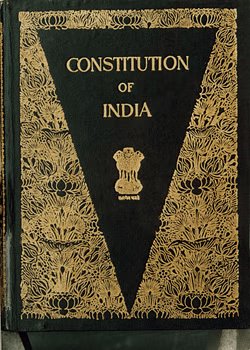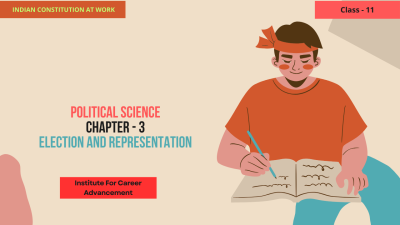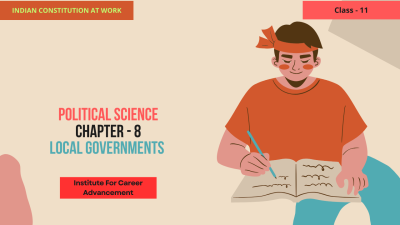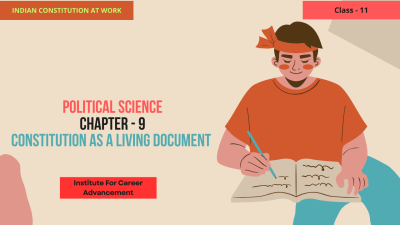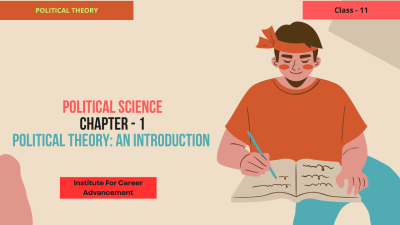Challenges to and Restoration of the Congress System - Class 12
The chapter on Challenges to and Restoration of the Congress System in Class 12 Political Science examines the evolution of the Indian National Congress as a political party from independence through the late 20th century. It focuses on the challenges the Congress faced during various political crises, particularly during the 1960s and 1970s, and how these challenges affected its dominance in Indian politics. Key Themes: Initial Dominance of Congress: After independence, the Congress emerged as the principal political party, successfully leading India through its formative years. Challenges in the 1960s and 1970s: The chapter discusses the internal and external challenges faced by the Congress, including: Growing dissent and fragmentation within the party. Rise of regional parties and increased political competition. Economic crises, including food shortages and inflation, which led to public dissatisfaction. The Emergency (1975-77): A significant focus is on the declaration of Emergency by Prime Minister Indira Gandhi, marking a critical period in Indian politics. The Emergency led to widespread political repression, suspension of civil liberties, and significant opposition to the Congress. Post-Emergency Period: The chapter explores the aftermath of the Emergency, including the 1977 elections and the formation of the Janata Party, which marked the first non-Congress government at the center. Restoration of the Congress System: The return of Indira Gandhi to power in the 1980 elections and the subsequent resurgence of the Congress party is analyzed. The chapter also discusses how the Congress adapted to changing political dynamics and the challenges posed by new social and political movements. Long-term Impact: The chapter concludes by examining the long-term implications of these challenges and restorations on the Congress party and Indian politics as a whole, setting the stage for the party’s strategies in the subsequent decades. দ্বাদশ শ্রেণীতে রাষ্ট্রবিজ্ঞানে কংগ্রেস ব্যবস্থার চ্যালেঞ্জ ও পুনরুদ্ধারের অধ্যায়টি স্বাধীনতা থেকে 20 শতকের শেষের দিকে একটি রাজনৈতিক দল হিসাবে ভারতীয় জাতীয় কংগ্রেসের বিবর্তন পরীক্ষা করে। এটি বিভিন্ন রাজনৈতিক সঙ্কটের সময়, বিশেষত 1960 এবং 1970-এর দশকে কংগ্রেস যে চ্যালেঞ্জগুলির মুখোমুখি হয়েছিল এবং কীভাবে এই চ্যালেঞ্জগুলি ভারতীয় রাজনীতিতে তার আধিপত্যকে প্রভাবিত করেছিল তার উপর দৃষ্টি নিবদ্ধ করে। মূল বিষয়ঃ কংগ্রেসের প্রাথমিক আধিপত্যঃ স্বাধীনতার পর, কংগ্রেস প্রধান রাজনৈতিক দল হিসাবে আবির্ভূত হয়, যা তার গঠনমূলক বছরগুলিতে সফলভাবে ভারতকে নেতৃত্ব দেয়। 1960 ও 1970-এর দশকের চ্যালেঞ্জঃ এই অধ্যায়ে কংগ্রেসের অভ্যন্তরীণ ও বাহ্যিক চ্যালেঞ্জগুলি নিয়ে আলোচনা করা হয়েছে, যার মধ্যে রয়েছেঃ দলের মধ্যে ক্রমবর্ধমান মতবিরোধ এবং বিভাজন। আঞ্চলিক দলগুলির উত্থান এবং রাজনৈতিক প্রতিযোগিতা বৃদ্ধি। খাদ্যের ঘাটতি এবং মুদ্রাস্ফীতি সহ অর্থনৈতিক সংকট, যা জনসাধারণের অসন্তোষের দিকে পরিচালিত করে। জরুরি অবস্থা (1975-77) প্রধানমন্ত্রী ইন্দিরা গান্ধীর জরুরি অবস্থা ঘোষণার উপর একটি উল্লেখযোগ্য দৃষ্টি নিবদ্ধ করা হয়েছে, যা ভারতীয় রাজনীতির একটি গুরুত্বপূর্ণ সময়কে চিহ্নিত করে। জরুরি অবস্থা ব্যাপক রাজনৈতিক দমন, নাগরিক স্বাধীনতা স্থগিত এবং কংগ্রেসের উল্লেখযোগ্য বিরোধিতার দিকে পরিচালিত করে। জরুরি অবস্থা পরবর্তী সময়কালঃ এই অধ্যায়টি 1977 সালের নির্বাচন এবং জনতা পার্টি গঠন সহ জরুরি অবস্থার পরিণতি অনুসন্ধান করে, যা কেন্দ্রে প্রথম অ-কংগ্রেস সরকারকে চিহ্নিত করেছিল। কংগ্রেস ব্যবস্থার পুনরুদ্ধারঃ 1980 সালের নির্বাচনে ইন্দিরা গান্ধীর ক্ষমতায় ফিরে আসা এবং পরবর্তী কংগ্রেস দলের পুনরুত্থান বিশ্লেষণ করা হয়। এই অধ্যায়ে আরও আলোচনা করা হয়েছে যে, কীভাবে কংগ্রেস পরিবর্তিত রাজনৈতিক গতিবিধি এবং নতুন সামাজিক ও রাজনৈতিক আন্দোলনের দ্বারা উদ্ভূত চ্যালেঞ্জগুলির সঙ্গে খাপ খাইয়ে নিয়েছে। দীর্ঘমেয়াদী প্রভাবঃ এই অধ্যায়টি কংগ্রেস দল এবং সামগ্রিকভাবে ভারতীয় রাজনীতিতে এই চ্যালেঞ্জ এবং পুনরুদ্ধারের দীর্ঘমেয়াদী প্রভাবগুলি পরীক্ষা করে শেষ হয়, যা পরবর্তী দশকগুলিতে দলের কৌশলগুলির জন্য মঞ্চ তৈরি করে।
English
Last updated
Wed, 27-Nov-2024







